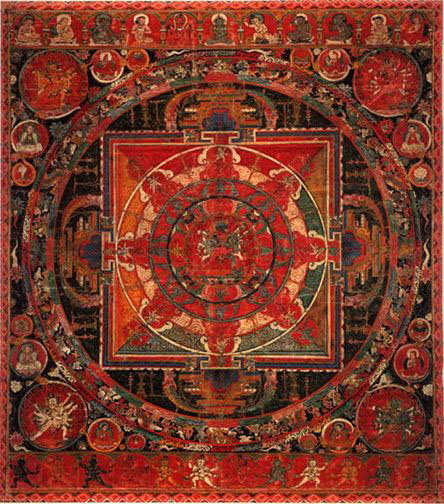| Cakrasamvara Mandala
'khor-lo bde-mchog-gi dkyil-'khor Central Tibet, ca. 15th century 64.3 x 55.3 cm |
|
This painting depicts the mandala of Samvara, often described as "the wheel of great bliss." At its center, the god Samvara embraces his consort, Vajravarahi ("the Adamantine Sow"). The god appears in his four-faced, twelve-armed form. Two arms stretch
an elephant skin behind him, others hold the hand drum, hatchet, chopper, trident, ceremonial staff, skullcup, noose, and head of the Hindu god Brahma; he grasps the bell and vajra as he embraces vajravarahi. His left leg is held taut, while the right k
nee is bent in a powerful stance (alidha) under which Bhairava and Kalaratri are trampled. Samvara and Vajravarahi are enveloped by flames. The couple appear at the center of five concentric circles of deities. In the first circle, on an eight-petaled lotus, are: Dakini (E), Lama (N), Khandaroha (W), and Rupini (S). Marking the intermediate points of the compass are skullcups atop vases, sa id to be filled with: the thought of enlightenment (bodhicitta, SE), blood (SW), the five ambrosias (pancamrta, NW) and the five illuminations (pancapradipa, NE). The second circle, described as the "circle of thought" (cittacakra) includes eight deities marking the main points of the compass and the intermediary points.1 Further groups of eight deities mark the third, fourth and fifth circles, said to be the circles of speech (vakcakra), body (kayacakra), and intuition (samayacakra), respectively. Ins criptions on the reverse include mantras invoking Samvara and a Tibetan transliteration of the Buddhist creed. 1 This mandala's iconography follows a description in the twelfth chapter of the NSP. For identification of the remaining deities in Samvara's circle, see Mallmann, Introduction a l'iconographie du tantrisme bouddhique, pp. 50-52 and 187-89. |
